 Thank you for visiting HOJO website. If you have any enquiry, please feel free to get in touch with us at
Thank you for visiting HOJO website. If you have any enquiry, please feel free to get in touch with us at
▼ Akira Hojo
▼ Hojo Newsletter
▼ HOJO FACEBOOK





HOME > Oolong Tea >Ali Shan Cha
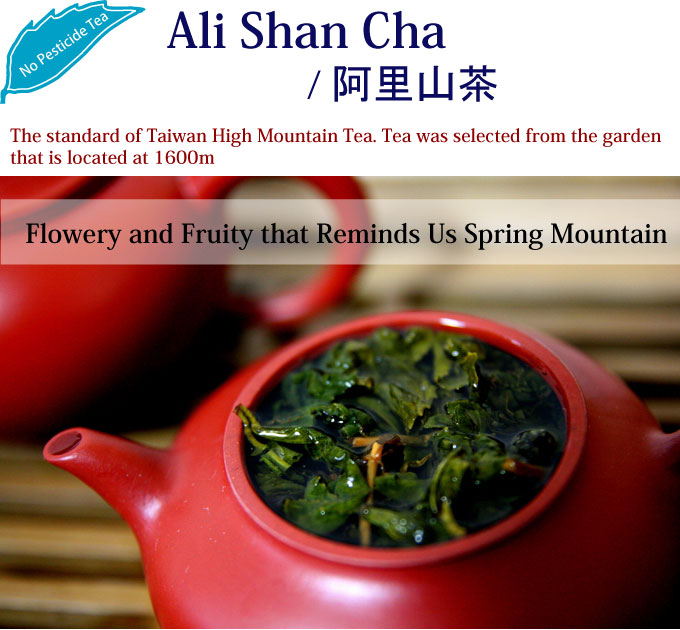
Ali Shan Cha is the standard high mountain tea in Taiwan. It gives very refreshing and flowery flavor with sweet after taste. This is the suitable tea is you would like to experience basic Taiwan high mountain tea.
Since our tea is made of the first plucked leaf in the season at highest elavation in Ali shan, we did not carry out baking process in order to maintain the original flavor of leaf. Our tea is not baked and therefore it gives very flowery and fruity flavor.
Tea produced any location on Ali shan is called Ali Shan Cha in fact. The lower the elevation, the more number of tea garden exist in Ali Shan. It often happens that tea made at 200-300 on the slope of Ali Shan is sold by the name of Ali Shan Cha. Of couse it is not incorrect. We are very particular about the altitide of tea garden as we wish to get stronger flavor. We are sourcing from the garden that altitude is at 1600m which is the highest point of tea garden in Ali Shan.
From one table spoon of this tea, you can brew nearly 1 liter of tea. Considering the volume of tea such little tea leaves can produce, this tea can no longer be regarded as expensive.


Ali Shan cha is the basic of Taiwan high mountain tea. The king of Taiwan high mountain tea, Li Shan gives very strong flavor, yet aroma is relatively weak due to extremely high altitude. Some people like Ali San Cha as it is well balanced between Aroma and Flavor. The character of Ali shan cha in term of flavor and aroma is similar to Dong Ding Oolong (No Fired Tea). The difference is that Ali shan cha is more delicate flavor and stronger flavor than Dong Ding Oolong.
For the customer who is beginning to drink Taiwan tea. We always suggest customer to start with Dong Ding Oolong and then move on to Ali Shan Cha.
It is wonderful tea if you drink morning to afternoon.
Once upon a time, legend has it that a farmer had left his tea garden unattended as he was too busy to look after it. His tea garden was terribly attacked by a large number of green flies. All the bitten tea leaves changed into yellow in color. Nevertheless, he still processed the tea leaves as he could not afford to give up his tea. To his surprise, the tea processed from insect bitten leaves gave a very strong fruity flavor. Coincidentally, a European tea merchant noticed this tea. He loved its quality very much and named it as Formosa Tea. It is believed that this is the prototype of Oriental Beauty. High Mountain Formosa is made following the basic technique of making Oriental Beauty but with further development. In Taiwan, this is not even known among the locals. It can be said that it is introduced to the overseas market for the first time.
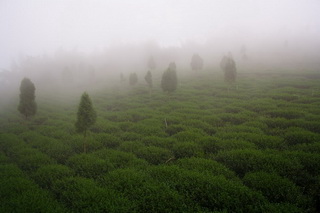
The tea garden is located on the Ali mountain (Ali Shan) at Nantou County in Central Taiwan. Ali Shan is very huge mountain that consist of many small mountains in a row. In general, the more number of tea garden exist at lower elevation and limited number exist at higher altitide. Both tea garden produce so-called Ali Shan Cha, yet quality is far different. Our Ali Shan Cha is carefully selected from the tea garden that is located at 1600m. The higher altitude gives significant beneft to the quality of tea as follow.
Higher up on the mountain, the sunshine is stronger. Likewise, we easily get sun-burned when we go to higher altitudes for trekking or sky diving. Tea receives a lot of sunshine in a day time and effectively carries out photosynthesis. Tea produces a lot of organic substances and stores them inside its leaf. At night, the tea leaves will consume the energy (organic substance) for metabolism. At high altitudes, the environment is very different and the temperature at night is very cold that tea can hardly proceed metabolism effectively. After all, most of the organic substances are accumulated inside tea leaves which makes the taste of tea becomes very thick.
In winter, the mineral absorbed by the tea trees from the ground will be accumulated inside the tree. It is because of the plant remains dormant during the very cold environment. This is the resting period of the plant. More mineral will be accumulated in the tree if the resting period is prolonged. The accumulated mineral will be distributed into the first up-coming tea leaves in spring. Mineral in tea is the primary element that contributes to the long lasting after taste. In a way, the longer the resting period of tea, the better the taste of tea.
At high mountain like Ali Shan, winter comes earlier while spring comes later as compared to lower altitude areas. As such, the tea trees has even longer resting period. Tea contains an extraordinary amount of minerals.
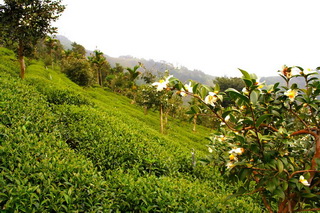
Our Ali Shan Cha Quig ?Xin is produced from Qing-Xin Oolong (青心烏龍種). This is the cultivars traditionally used for Dong Ding Oolong that gives a very refreshing taste. The taste of tea made of this particular cultivar is flowery and sharp, yet it gives long lasting taste that longer on our throat.
Tea grown at organic garden appears to be less active and less productivity as tea gets less nutrition and pesticide as compared to the ordinary tea garden. As the identical characteristics, tea leaf turns into yellow color and sweetness in flavor and taste is outstanding.
Plucking is carried out by hand. 3 to 4 leaves including a bud is carefully plucked. Plucking is carried out in Spring, Summer, Autumn and Winter. The best quality is produced either from Spring or Winter. At the lower elevation in Ali Shan, plucking is sometimes carried out more than 10 times. Less number of plucking allows longer resting period to the tree that enable tea to absorb more mineral.
Our Ali shan cha is grown at 1600m. Thanks to the limited number of plucking throughout the year, tea contains more amount of mineral that gives strong flavor.
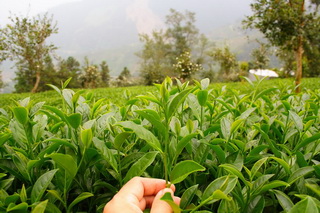

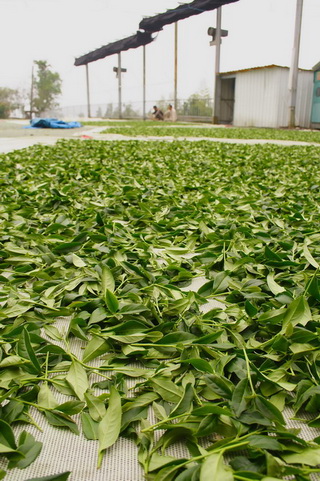
After plucking, the tea leaves are spread over the ground under the natural sunshine. It is called Sunshine Withering. Usually clouded weather is ideal to grow this tea in order to avoid excess damage on tea leaves. If the sunny weather continues, a black cloth is used to cover the tea leaves to block out the harsh rays of sunshine. With sunshine withering, moisture inside the tea leaves gets evaporated and fermentation is moderately triggered. The tea leaves will gradually start releasing a refreshing aroma.
The method of fermentation for oolong tea is completely different from that of black tea. After the sunshine withering is completed, tea leaves are conveyed into the factory and spread over a sheet.
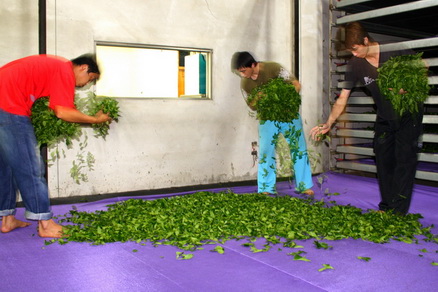

If the tea leaves are rich in moisture, they are spread into a thin layer in order to increase the evaporation process. The tea leaves are then tossed onto a bamboo tray. This agitation and tossing, causes friction and bruises the tea leaves which in turn causes the tea leaves to start fermentation.

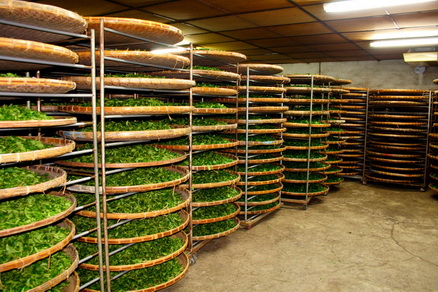
The tray is then placed on a rack and these processes are repeated several times. This is called fermentation. Tea leaves gets oxidation mediated by the oxidative enzyme when the tea leaves get bruised.

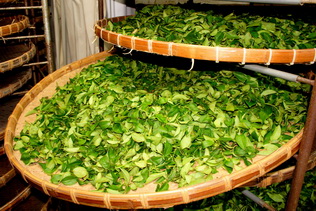
Once entering the fermentation room, you might be surprised with its fragrance. You feel as if you are in a flower garden. Subsequently tea leaves are rotated in a bamboo drum. The tea leaves are lifted and dropped several times. Gradually the edge of tea leaves get damaged and further fermentation takes place. Tea leaves are again spread over the bamboo tray and the same process is repeated over and over again.
Once tea leaves get sufficient fermentation, it starts generating a flowery fragrance. Tea that is processed by a fine tea master is easily distinguishable. The original shape is maintained without any damage done to the tea leaves and only the edge of tea leaves are found to be red in color. This indicates that the tea leaves were successfully semi-fermented and the quality is far different from the tea leaves which have a reddish appearance at the center part of the leaf. Once the tea master finds that fermentation is sufficiently achieved, the tea is then sent for heat treatment in order to arrest further fermentation process. If this is not carried out swiftly, the tea leaves will keep on fermenting and it will finally turn into black tea.
The number of rotation and timing of fermentation is judged based on the moisture content, flavor and color. This decision requires top-notch experienced tea technicians which affects the quality of tea tremendously. All technicians follow the instruction of a tea master. In order to get good quality tea, we need to pick out an excellent tea master.

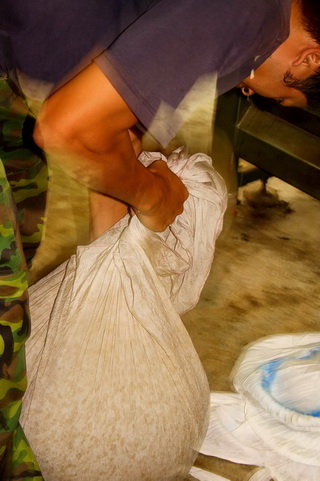
At this stage, tea is fermented and gives an identical character of Dong Ding Oolong. However the tea leave have not been damaged or bruised except for its edges. Without physical damage on tea leaves, it is difficult to "brew". On the other hand, conducting the rolling process as black tea where tea leaves are twisted tautly under strong pressure, the tea leaves will be excessively damaged and will be astringent and harsh in taste. In addition, excessive damage of leaves expose constituents to the oxygen and cause unwanted oxidation that will also affect to the taste and flavor. Therefore the very unique rolling process called "Bag rolling" is used for oolong tea. Literary tea leaves are wrapped in a piece of cloth and rolled. Therefore, the tea leaves are twisted just right with the right amount of pressure applied.
While the tea leaves are still warm and soft, it is quickly wrapped in a cloth bag. About 10-20kg of tea leaf is wrapped and it is made into the size of about a basket ball. Then the end of cloth is mechanically twisted by machine in order to squeeze it into a very solid ball. Finally it becomes as solid as a stone ball and as a result the tea leaves are compressed very tightly.


Then, the cloth ball is clamped between disks at the top and bottom. The top disk does not move while the bottom disk rotate and tea gets further pressure through the motion. After the rolling process is conducted for a while, the bag is opened and the tea leaves are taken out and reheated again in a rotating drum. This is necessary as once the tea leaves cool down, it becomes crispy and easily crushed. This series of processes are repeated several times until it is well rolled.
The tea leaves are gradually tighten and become round in shape. High grade tea is usually very solid and it appears to be dark and shiny as the juice of the tea leaf is squeezed and hardens on the surface of the leaf.
The same sequence is repeated several times. The parameter is varied depending on the condition of leaf such as moisture content. It is important to feel the condition of tea leaf and apply the suitable method of process which is judge expertly by the tea master.
After this rolling process is completed, the tea leaves are dried and this will reduce the moisture content down to 5%.
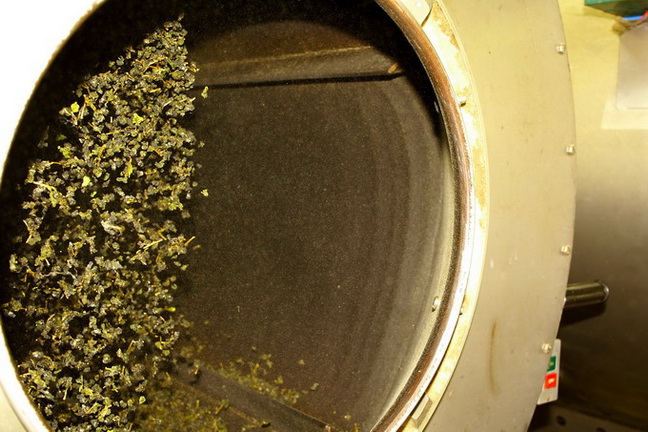
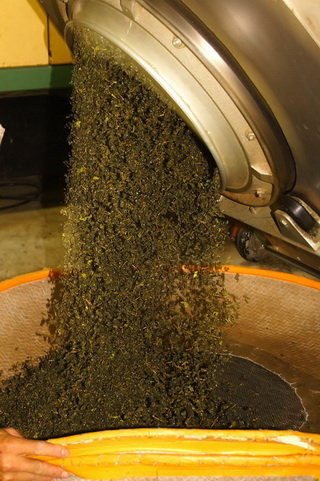
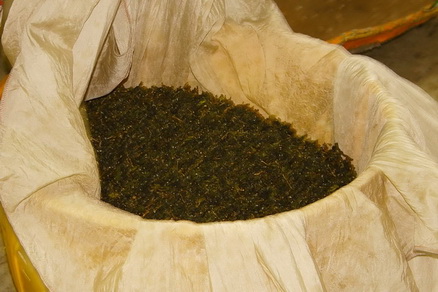
Tea leaf is tight, round in shape and solid. The size of tea leaves is consistent and its surface is lustrous. Good quality tea are weighty when you hold some quantity with your palm you can most certainly feel its weight.
Good quality tea consists of tea leaves with consistent size and shape. The same shape indicates that good technique in tea making process and good material is used.
There is no foreign material such as fiber, bamboo, piece of wood, sand or stone.
When it is brewed, it gives refreshing fruity and flowery aroma and flavor. This flavor lasts even after several brewing.
Bright and transparent, in golden yellowish color, and not dusty.
Smooth and midium strenght of after taste. It gives sweet feeling in taste too.
Tea leaves are very tender and elastic. It contains less broken or cracked leaves. Looking at the cracked leaves, we can understand the reason what caused the crack. If the cracked part shows a reddish color, it indicates it was damaged when enzyme was still alive, which means that crack was made before Rolling Process. This shows that either the leaves were not properly handled or tossing was too rough. If the cracked part remains green in color, it indicates the tea leaves were cracked during the rolling process or too excessively dried.
Many customers are afraid of brewing oolong tea as it seems very difficult. However it is not that difficult once you understand the theory.
At first, bring the cool water to boil. Use soft water for preparation of tea. The water processed by distillation or reversed osmosis is not suitable for brewing tea. These water contains no minerals and it will cause tea to become tasteless. If normal tap water is used, it is advisable to use a filter. Boil the water just before brewing tea. It is very important to boil water so as to evaporate the chlorine and other types of contaminated substance in the water. Do not continue boiling for more than a few minuets as it will rather concentrate the mineral and the character of water may be converted to hard water.
The important point for brewing oolong tea is:
1) Use boiling water. 2) Avoid drastic decrease of water temperature. The sweet taste of green tea comes from the substance called amino acid which can dissolve in the water at a lower temperature. Therefore, low temperature is applied only for green tea. On the contrary, the taste of oolong tea comes from poly phenol and its oxidized substances. Those substances could only dissolve in the water at high temperature. In other words, you would not enjoy the real taste of oolong tea if it is brewed at a lower temperature. The taste of oolong tea very much depends on the brewing method.
Go to further information about suitable water for brewing tea >>
In order to enjoy oolong tea, always ensure that the water temperature is very hot. Use boiling water and rinse tea pot with boiling water to keep it hot.
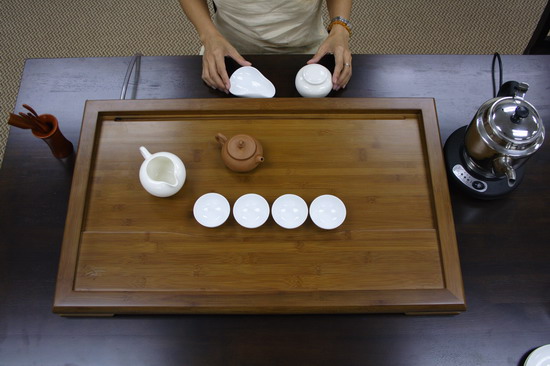
Arrange tea ware.
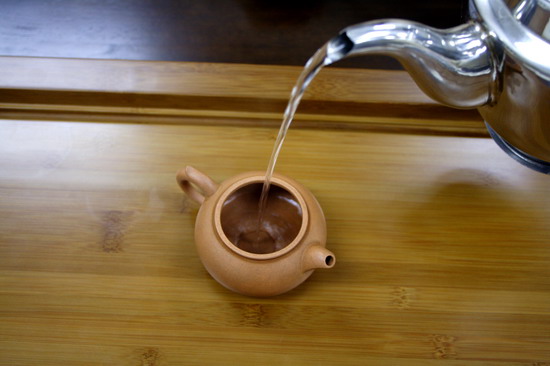
Pour boiling water into the tea pot and fill up to 70%-100%. This is to heat up the tea pot. If the pot is not warmed up, the temperature of water will drop drastically at around 20 degree C when a cold tea pot is used for brewing tea. This will affect the taste and flavor of tea.
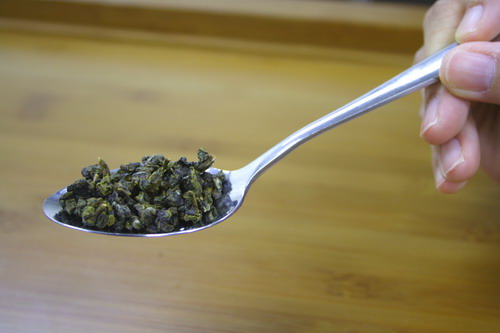
Usually 1g is equivalent to 25〜50ml of water. For the small tea pot of 150〜250ml, about 5〜6g of tea leaves is sufficient, which can be measured by 1 table spoon.
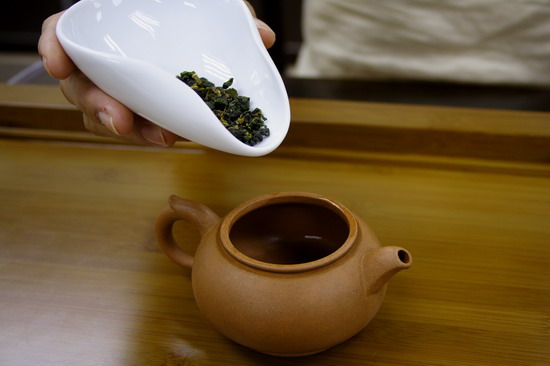
Place in about 5g of tea leaves. This photo shows the inspection plate which is convenient for placing the tea leaves. If the lighter taste is preferred, reduce the quantity of tea leaves.
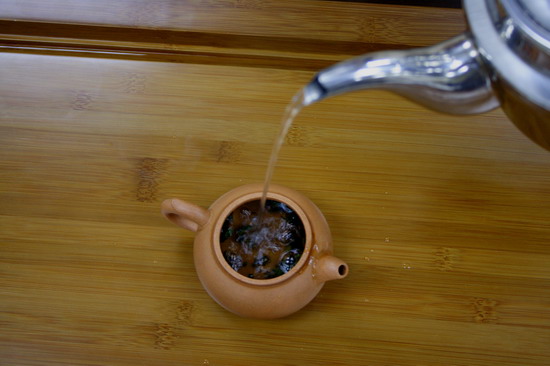
Pour in the hot water. When pouring water, try to pour from lowest position. Pouring from higher position, temperature get cooled down quuckly.
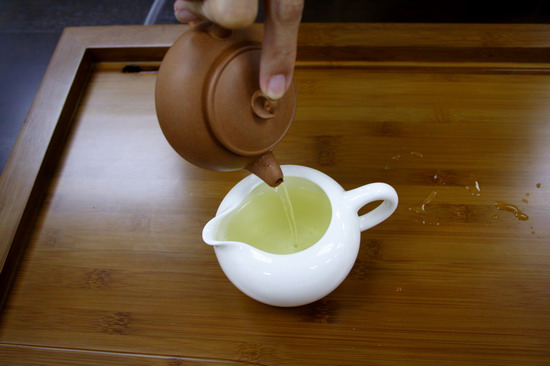
Within 10 seconds, pours off hot water into pitcher. Usually we recommend 7 seconds. The first brewing is to open up the tea leaves and warm up tea leaf.
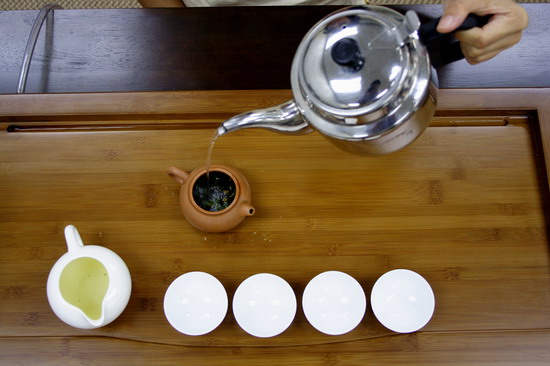
Pour boiling water into tea pot up to 90%.

Gently place the lid and leave it for 55 seconds. For second brewing leave it for 45 seconds, follow by 55 seconds for the third brewing.
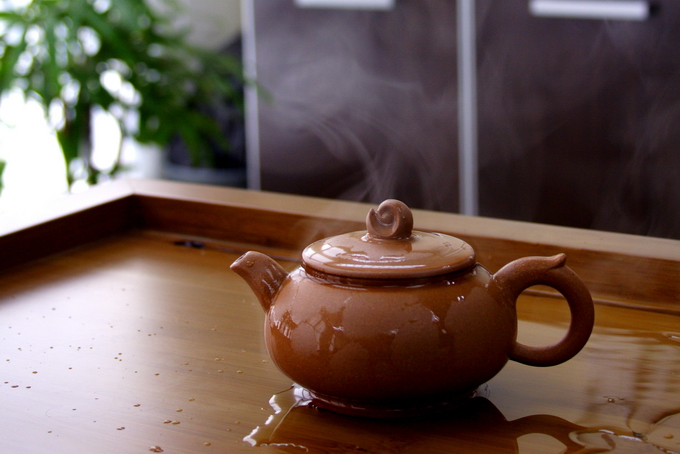
You can also pour boiling water over the cap in order to keep the tea pot warm. But this method is not a must.
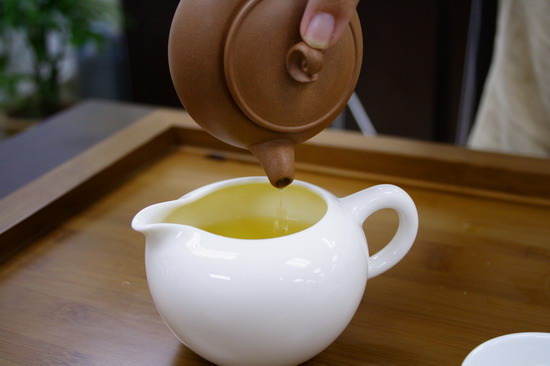
Pour tea into a pitcher completely until the last drop which is most concentrated. It is important to keep the tea leaves without liquor before subsequent brewing. Steeping the tea leaves in hot water will caused damage to the tea leaf.
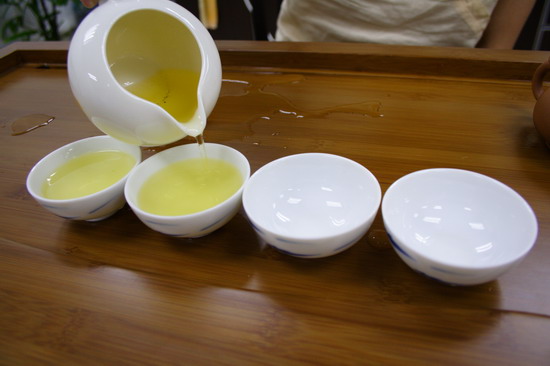
Pour tea from the right end which is supposed to be served for the guest. The one on the left is for the host.
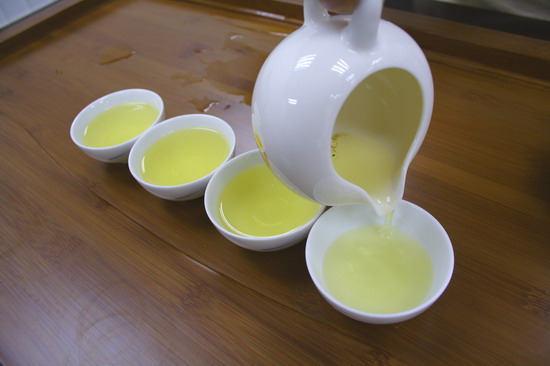
The last cup of tea (on the left) contains the small piece of tea leaves. This is for the host.
If you think that the above method is too difficult or not suitable, always develop your own method.
Enjoy a nice cup of tea as long as you follow the key points:
1) Use boiling water; 2) Do not cool down the water temperature.
For example, you can use a glass cup. When preparing the tea, after pouring boiling water into the glass cup, cover it tightly. It is also one of the ways. It is very interesting to learn about traditional methods as we can also enjoy the culture through the preparation of tea. However this is not a must. Under the circumstances, sometimes it is necessary to change the method.
Once a bag of tea is opened, please finish it within 3 months if you wish to enjoy its freshness. From the medical point of view, it is safe to consume the tea even if it is kept for a few years. However the freshness disappears if it is kept for too long. Tea must be tightly sealed before it is kept. Tea should be kept in ambient and dry conditions such as in the living room, but it must be completely away from humidity. Tea should not be kept in the kitchen as the environment is very humid. Avoid enclosed area such as inside the cupboard or drawer as these places are damp. Also avoid opening the bag of tea in humid atmosphere. It is recommended to open the bag during a sunny day or under air-conditioned atmosphere. Once tea leaves absorb moisture, deterioration of tea will be triggered within a few days. Tea will then give an astringent taste, sometime it tastes sour. The fresh aroma also becomes weaker.
The quality of tea lasts longer if it is kept in the fridge. However we strongly recommend you not to keep tea in the fridge. When tea is withdrawn from the fridge, there is usually condensation. Once tea is exposed to moisture during condensation, the quality will deteriorate within a few days. The higher moisture content in the tea leaves will trigger oxidation and it will completely destroy the quality of tea.
Here’s one frequently asked question: what happens if bag is sealed using tape or tea is packed in zipper bag and kept inside the fridge?
For your information, these simple sealing methods are not sufficient. When the bag is withdrawn from the fridge, it is cold inside the bag and therefore causes negative pressure. Air will be drawn from outside and condensation will occur. In addition, if the bag is taken in and out from the fridge very often, this will cause heat stress to the tea leaves as temperature is increased and decreased very frequently. If tea is kept in the fridge, when it is withdrawn from the fridge, it is necessary to leave it in ambient atmosphere for more than 24 hours in order to warm up the tea leaves. Based on our experience, 12 hours is not long enough. We may think tea is warmed up, but inside the bag, the tea leaves are still cold due to insulation effect.

Please feel free to send us e-mail for enquiry at:

 |
We accept various kinds of credit card through Paypal.
Only if customer prefer other option of payment, we suggest "Bank Transfer".
Various choice of shipping method
EMS, SAL, Small Packet, Small Packet (SAL) Yamato Express and Surface
For shipping tea, we usually suggest small air parcel, the estimated shipping cost of tea in 100g (with wrapping material ) is
Small Parcel
USA JPY 600, EU JPY600 and Asia JPY470
Small Packet (SAL)
USA JPY380, EU JPY380 and Asia JPY320
The shipping fee to oversea by small air parcel happens to be even cheaper than domestic shipping fee in Japan.
For your information, some countries, EU in particular imposes custom duty. We need buyer to bare the duty. We are sorry, but we cannot change the amount on the invoice, and we do not mark any packages as gifts. We will strictly follow the custom regulation.